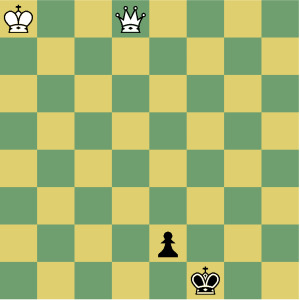The importance of chess endgame strategy
It is very common for chess games to come down to an endgame, and very often those endgames amount to a single Pawn or a Pawn for each side (plus the Kings, of course). In order to win more chess games, you must know endgame strategy for these simple endings.
Queen v. Pawn strategy
Take a look at the following endgame diagram. Black’s Pawn, sitting on e2, is one step from promoting. If it were Black’s move, he can draw the game by simply moving 1…e1(Q). Draw!

But it’s White’s move. The players each have a simple overall strategy for winning (or drawing) this game. White’s strategy is to capture Black’s pawn. In order to do that, he must do two other things: he must first prevent Black from promoting his Pawn, and he must attack the Pawn with both his King and Queen (the Queen alone can’t safely capture the Pawn as long as Black’s King guards it). In order to do this, White must bring both his King and Queen to bear on the Pawn; both must attack the Pawn at the same time.
Preventing Black from promoting the Pawn can be done by pinning the Pawn and keeping Black busy with checks against his King. Bringing White’s King closer requires that Black have his King in front of his Pawn, physically blocking the Pawn from the promotion square. This will give White a free move (a tempo) to move his King closer to the Pawn. Each time Black’s King sits on the promotion square, White has a free move to bring his own King closer to the action.
Black, on the other hand, wants to promote his Pawn to Queen (which would result in a draw). In order to do that, Black wants to both protect his Pawn from capture while leaving the promotion square open so that if he gets a chance, he can push the pawn to e1.
Black’s strategy is simple; and while White’s strategy is equally simple, executing the strategy requires careful maneuvering.
Here are the moves for finishing this mate. The starting position is in the diagram above. Also listen to the video for my additional comments about the position and White’s techniques for winning the game.
- Qf6+ Kg1
- Qe5 Kf1
- Qf4+ Kg1
- Qe3 Kf1
- Qf3+ Ke1
White has driven the Black King in front of the Pawn (which Black has resisted as long as possible), preventing Black from promoting and giving White time to bring up his King. Achieving this position is one of White’s intermediate strategic objectives. Watch how White brings about this position several times in order to give his King opportunities to move closer to the action.
- Kb7 Kd2
- Qf2 Kd1
- Qd4+ Kc1
- Qe3 Kd1
- Qd3+ Ke1
- Kc6 Kf2
Avoiding Kf1, which would be moving into a pin and would give White a “free move” to bring the King closer.
- Qd2 Kf1
- Qf4+ Kg1
- Qe3 Kf1
- Qf3+ Ke1
- Kd5 Kd2
- Qf4+ Kd1
- Qd4+ Kc1
- Qe3 Kd1
- Qd3+ Ke1
- Ke4 Kf2
Now the White King is close enough to help in both attacking the Black Pawn and delivering checkmate to the Black King. You can’t give checkmate with the Queen alone … the Queen needs some help (from either friendly or enemy pieces) to checkmate the King.
- Qf3+ Kg1
- Qe2 Kh1
- Kf3 Kg1
- Qg2# …
This ending works every time against a Knight-pawn or center-pawn (the b-pawn, d-pawn, e-pawn, or g-pawn). The Rook-pawns and Bishop-pawns can be more tricky and sometimes impossible to win. That will be the subject of another post soon.
This chess endgame is very important to know, and it is surprising how few average tournament players know this ending. If you play enough chess, this will come up. You should know this well enough to be able to play it without thinking. Well … at least not thinking too much. 🙂
You can find this endgame in Reuben Fine’s masterwork, Basic Chess Endings (look at diagram number 544).

very, very useful
thanks
meh, seems an obvious maneuver
Hi, i just discovered your blog and i find it awesome!
But I have a question: why didn’t black player moved at 5. Qf3+ e:f3 and force a draw?
Or it’s just for the purpose of studying Queen vs Pawn?
Thank you
5. e:f3 (for those who don’t know, the notation “e:f3” is the same as exf3 or ef, and indicates a pawn capture ending on f3) would have the Black Pawn moving backward. The Pawn could capture on f1 or d1, but not on e3. That’s a useful thing to point out … the Queen has to avoid landing on f1 or d1. 🙂 Thanks for the question Tiago.
Interesting! That sticky thing caleld Life has put me on a sparse chess diet. I am more or less restricted to 30 minutes of chess per day.How do you like the Chess Master School?
I would highly recommend the Chess Master School.